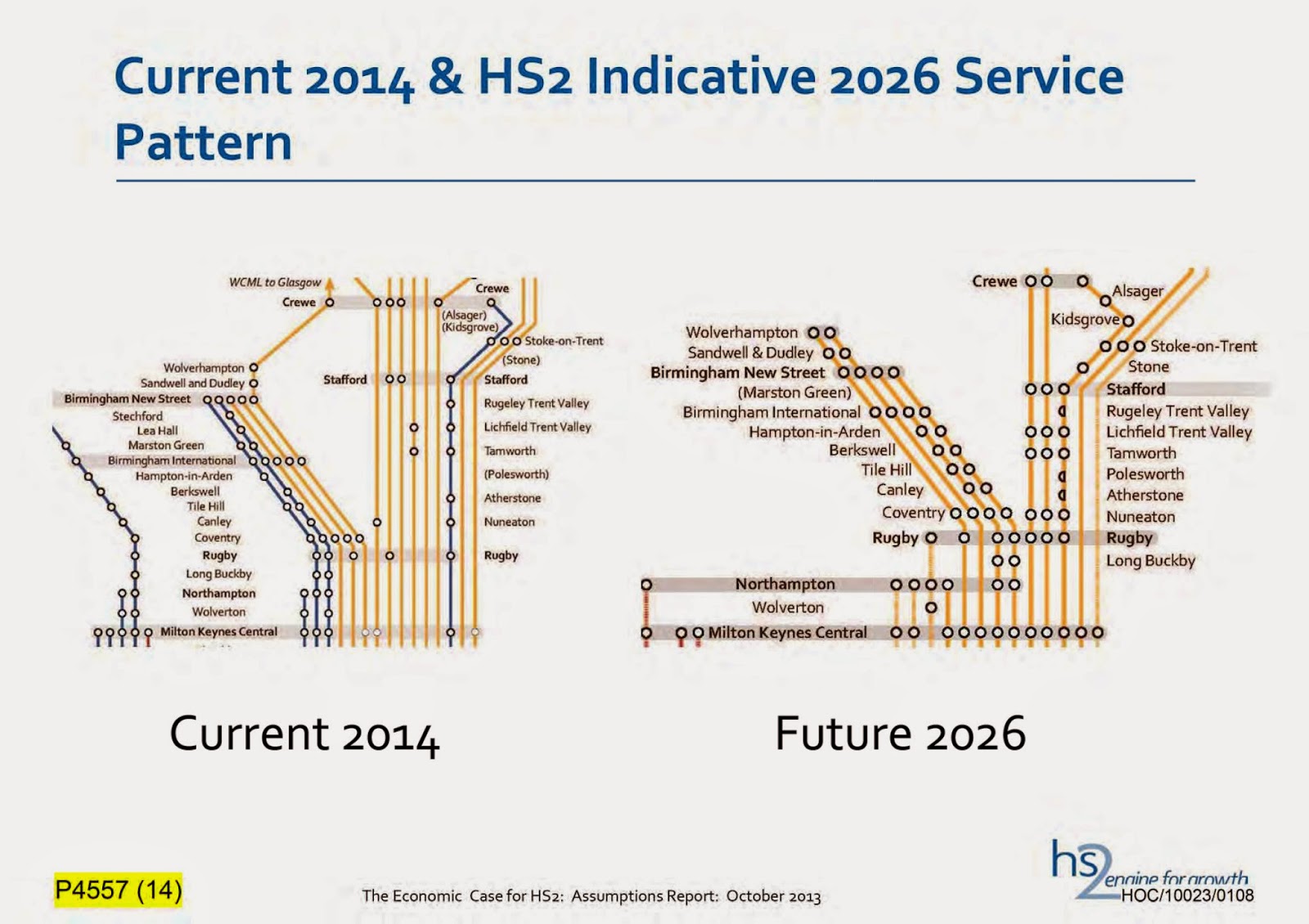 |
| Despite suggestions to the contrary by HS2 opponents, Prof McNaughton's slides made clear the increases in services which could be provided using capacity released by the first phase of the project. |
Professor Andrew McNaughton, Technical Director of the government's project delivery company HS2 Ltd, called it a ‘something of a canter’. But in reality, his appearance on February 11 before the committee of MPs scrutinising the first phase of the planned High Speed 2 railway network was a(nother) landmark moment, as it shone a light on one of the project’s most important assets.
In short, over these eight pages (pp41-49), McNaughton attempted to set out to MPs the nebulous, fraught and technocratic issue of ‘released capacity’. We hear it quoted so often as an advantage of HS2, but rarely do we see precisely how the hard bitten rail traveller – he or she with no inclination to board a long-distance train to London or Newcastle or Rotterdam or anywhere – might stand to benefit. And benefit a lot.
‘In each hour in the peak, because of HS2, there is the opportunity for the stations served by the West Coast Main Line to have around 6 000 to 7 000 extra seats. That is what released capacity equates to.’
McNaughton, not for the first time, sought to illustrate the issue by outlining, subtly yet effectively, how inefficiently our ‘patch and mend’ policies have led us to use our most strategic infrastructure, in the case the (notionally-upgraded) West Coast Main Line. In doing so, he drew a parallel with the country’s most capacious railway, London Underground’s Victoria Line.
‘If you recall, a few minutes ago, I said, in theory this is all non-stopping trains all going at the same speed, two minutes apart. You could end up with 30 trains an hour or, if they’re all stopping like the Victoria Line in the London Underground, 30 trains an hour. The practical limit on the WCML [fast tracks] today is 11 long-distance trains and four outer commuter trains, and there are trains on the slow lines as well. I’m going to concentrate on the fast lines. 11 plus 4 is 15.
'What does HS2 release? We take off the main line most of the long-distance non-stop services, because the purpose of HS2 is to serve cities on the long-distance network. That means in the peak we see at least 10 totally new services are available in the capacity that we released on the WCML.’
So, in a nutshell, we have a situation where we have a very old, but very expensively modernised, railway operating significantly below its theoretical capacity. That’s path occupancy of course, whereas much media brouhaha has focused on the question of seat occupancy or load factor. McNaughton addressed this too, noting that the provision of seating is a function of the number of train paths the railway is able to offer up. So needless to say, more seats might be occupied if more intermediate stops were inserted into long-distance trains on the WCML. Easy, right? Wrong:
‘The practical capacity is an operational capacity and this is not a fixed function for any particular railway; it is a function of how train services are planned on that infrastructure. I give some examples of how the way train services are planned affects the number of trains, the number of seats per hour, the number of stations, whatever, that can be served on a route.’
And the problem with the WCML – and the three other principal rail arteries HS2 would relieve in its second phase – is that, as McNaughton showed in his slides, it has to serve places en route, the ‘points A, B, C and D’ he cited. In commercial reality, B, C and D get a pretty raw deal: very few Virgin Trains expresses heading to or from London stop much south of Stoke, Crewe or Warrington. If they did, McNaughton reported, they would compromise the available paths for the two or even three trains behind. Then of course, any perceived load factor deficit would immediately evaporate.
As this blog pointed out recently, there is no longer any regular direct rail service between Watford and any destination in northwest England. A clear opportunity for the kind of inter-regional service which could (and in my view should) be offered in one of the 10 freed-up paths indicated by McNaughton.
It cannot be repeated enough that the fundamental usage of HS2 is already established. The services that will use it will in fact look remarkably familiar: faster and much, much more reliable, but still three fast trains from London to Birmingham and three fast trains to Manchester. The business case is a transferral and enhancement, not the dreaming up of a new market.
Indeed, of the 30 stations proposed to be served by HS2 trains once both phases are open, 21 are exactly the same stations as served by the equivalent services today (Warrington, Glasgow, York, Newcastle, London Euston and Manchester Piccadilly are among those in this group).
Unsurprisingly, and without reference to the slides that accompanied McNaughton’s presentation, those who remain dogmatically opposed to the HS2 programme leapt before looking. Others have highlighted the gross misrepresentation of Stop HS2’s description of McNaughton’s presentation, but such heat and light obscures the reality that our time-honoured patch and mend philosophy has led us to spend £10bn on a railway which afterwards defies efficient or reliable operation.
As we near the frenzy of a General Election campaign, primary evidence of a technically-credible nature is sure to be in short supply. Like Chris Gibb’s landmark report before it, McNaughton’s contribution is a vital one. HS2 can herald not just a highly-effective railway in its own right, but it can also unlock the potential of our legacy network. It must be built.
